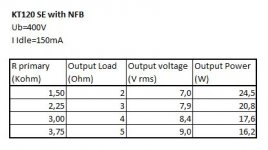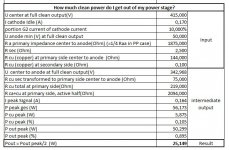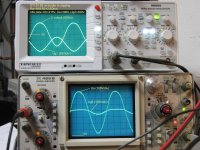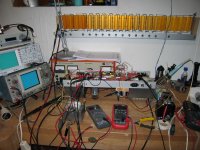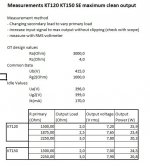Thanks much to all for that great info! Will digest an no doubt have additional questions.
Joe
Joe
There is not too much detailed data available about the KT150. Based on my measurements it is an "extended" KT120. Here is a quick an dirty excel to roughly estimate the range of output power of a Class A SE. Input is Ub(V), Ra primary(Ohm), lowest voltage (V) of the anode when starting clipping and the remaining anode current (mA) at the positive AC signal peak. The calculation is based on a pure sine wave ignoring all nonlinearities. The output is the estimated output power, the resulting class A anode current and the anode power dissipation based on that current.
I have put in some configs.
Hans- Georg
So I'm gathering that in my current project, 22W from a KT120 into 2.5k at just under 400V should be realistic and sustainable?
Joe
Joe
Agreed. The actual used value might be too optimistic. As I stated, the anode low voltage parameter is an input cell to play around with.
Hans- Georg
It took a litttle bit of time to create a quick and dirty prototype, here is my measurement of KT120 SE. I have varied the primary load by changing the secondary load. The measurements is done with an RMS voltmeter just before clipping (checked with a scope).
Hans- Georg
Hans- Georg
Attachments
Thanks! What was the screen voltage used for the tests?It took a litttle bit of time to create a quick and dirty prototype, here is my measurement of KT120 SE. I have varied the primary load by changing the secondary load. The measurements is done with an RMS voltmeter just before clipping (checked with a scope).
Hans- Georg
So here are some more details, please have a look to the right table attached. In addition to KT120 I have measured 2 points of the KT150 for comparison. Interesting to see that basically there is no significant difference between the KT120 and KT150.
The scope picture illustrates a little bit:
- upper scope: output power and control grid signal at the output tube
- lower scope: Ua and Ug2
If you look to the output power you implicitely can see the 2nd harmonics at the level to clipping, typical for SE output stages. Interesting: Ua min is 40V.
I have made a power output estimation including the DC resistance of the OT(primary=144Ohm(measured) and secondary 0,1Ohm (estimated)). The calculated estimation is 25,1W at Ra=1875Ohm (left table). The measured result is 23,4W, so thats what I call "in the ballpark".
And just for fun: the other picture shows what I call "quick and dirty": I have used my PP testbench, removed one output tube, exchanged the PP OT by an SE OT (left side) and put in a choke (right side) to the G2 supply.
Hans- Georg
The scope picture illustrates a little bit:
- upper scope: output power and control grid signal at the output tube
- lower scope: Ua and Ug2
If you look to the output power you implicitely can see the 2nd harmonics at the level to clipping, typical for SE output stages. Interesting: Ua min is 40V.
I have made a power output estimation including the DC resistance of the OT(primary=144Ohm(measured) and secondary 0,1Ohm (estimated)). The calculated estimation is 25,1W at Ra=1875Ohm (left table). The measured result is 23,4W, so thats what I call "in the ballpark".
And just for fun: the other picture shows what I call "quick and dirty": I have used my PP testbench, removed one output tube, exchanged the PP OT by an SE OT (left side) and put in a choke (right side) to the G2 supply.
Hans- Georg
Attachments
In SE, it would be more realistic to use a RL between 3.5K and 5K into 8ohms for either tube. It would lower the power output slightly and change the distortion measurements as well. You should still be able to get close to 20W out.
The manufacturer has revised the spec to 200W from a pair compared to the previous 300W output.
The manufacturer has revised the spec to 200W from a pair compared to the previous 300W output.
I tried the KT120 in my Mikael Abdellah SE amp. Only briefly as the power trans is underpowered. Also the James OPT's only allow 100mA max current. So I was using far from ideal operating points.
I loved the sound. This is the only tube I have tried in this amp that sounds good in UL mode. If you want a SE amp that also plays rock, then I can highly recommend the KT120.
I am going to build a KT120 PP amp next.
This is a really exciting new production tube IMHO.
I loved the sound. This is the only tube I have tried in this amp that sounds good in UL mode. If you want a SE amp that also plays rock, then I can highly recommend the KT120.
I am going to build a KT120 PP amp next.
This is a really exciting new production tube IMHO.
Last edited:
Agreed -- and more importantly, I think it's really significant that not only are older models being supported, but new models being introduced. Moreover, I recently noticed that some hitherto obsolete units are being re-introduced. Don't recall the specific model, but it was one of those dual pentode/triode units. LONG LIVE HOLLOW STATE!
I tried the KT120 in my Mikael Abdellah SE amp. Only briefly as the power trans is underpowered. Also the James OPT's only allow 100mA max current. So I was using far from ideal operating points.
I loved the sound. This is the only tube I have tried in this amp that sounds good in UL mode. If you want a SE amp that also plays rock, then I can highly recommend the KT120.
I am going to build a KT120 PP amp next.
This is a really exciting new production tube IMHO.
Here the curves from KT150 by Sofia
http://www.diyaudio.com/forums/tubes-valves/268596-kt150-curves-sofia.html
The tube as triode has a low internal impedance and 1800-2000 ohm can be a good choice for this configuration.
Soon I will check this configuration with a new se trafo; I think that 12 w on 8 ohm can be reached with a low distortion. With 50 w of plate dissipation at 70% of max capability.
I worked with KT120 but the 150 seems to be more intersting; the specs are quite similar but the mechanical aspect is more robust.
Walter
http://www.diyaudio.com/forums/tubes-valves/268596-kt150-curves-sofia.html
The tube as triode has a low internal impedance and 1800-2000 ohm can be a good choice for this configuration.
Soon I will check this configuration with a new se trafo; I think that 12 w on 8 ohm can be reached with a low distortion. With 50 w of plate dissipation at 70% of max capability.
I worked with KT120 but the 150 seems to be more intersting; the specs are quite similar but the mechanical aspect is more robust.
Walter
Could you please post the pentode curve as well, so it can be compared with the ones shown in the datasheet, which is all we have to go by until now...Here the curves from KT150 by Sofia
Thanks,
Parenthetically, is it normal for a company to release a product with such a dearth of detailed information? These have both been out for long enough at this point for some official technical data to have been made available.
Could you please post the pentode curve as well, so it can be compared with the ones shown in the datasheet, which is all we have to go by until now...
Thanks,
These have both been out for long enough at this point for some official technical data to have been made available.
I've asked Tungsol twice if they can supply UL curves for the KT120 and have received no reply........
I have used kt120s in 75w bass amps, essentially cloning a Fender 75. Everything ran cooler and output was cleaner at 75w. Max op was 80w, but with tubes anything within 10% is close enough. Is it worth the extra fifty bucks or so? NO!
I am ultra disappointed that NOBODY making these things has published any recommended operating conditions for various voltages and loads as did GE, RCA or Philips etc. Info on using 6L6/6550/Kt88/El34/7581a and so forth floods the tube manuals. (That's where my first decent amp got it's start back in 1964)
It's all fine and dandy to advertise"capable of 150w from a single pair of KT120s" but quite another to say how it's best accomplished! BTW a softly regulated screen supply does wonders for o/p specs....
Just sayin......
I am ultra disappointed that NOBODY making these things has published any recommended operating conditions for various voltages and loads as did GE, RCA or Philips etc. Info on using 6L6/6550/Kt88/El34/7581a and so forth floods the tube manuals. (That's where my first decent amp got it's start back in 1964)
It's all fine and dandy to advertise"capable of 150w from a single pair of KT120s" but quite another to say how it's best accomplished! BTW a softly regulated screen supply does wonders for o/p specs....
Just sayin......
Hi
in next mid January I will start with a new power amp, monos with KT150 in pentode connection.
I will send the curves by Sofia.
I have built a similar with 4x KT120 each amp and I reach about 220 w in impulsive signal with max of 2% of THD. The Vdc was 420 Vdc.
The test was made win Audioreview lab with a specific program who send continuos and impulsive signals monitored by an Audio Precision with a specific test configured. It also change in automatic the load from 16 ohm to 2.6 ohms for each part of test.
The new amps will run at 520 Vdc; the out put transf. will be a double C with a single sec. at 5 ohms and primari at 1800 ohm A-A.
Walter
in next mid January I will start with a new power amp, monos with KT150 in pentode connection.
I will send the curves by Sofia.
I have built a similar with 4x KT120 each amp and I reach about 220 w in impulsive signal with max of 2% of THD. The Vdc was 420 Vdc.
The test was made win Audioreview lab with a specific program who send continuos and impulsive signals monitored by an Audio Precision with a specific test configured. It also change in automatic the load from 16 ohm to 2.6 ohms for each part of test.
The new amps will run at 520 Vdc; the out put transf. will be a double C with a single sec. at 5 ohms and primari at 1800 ohm A-A.
Walter
I would be interested in opinions on the claims of an amplifier designer who states the following for his amplifier running a pair of KT 150's per channel. Infortunatly any more in depth information re its topology has not been forthcoming, however, Can this design be claimed to be a True Class A amplifier at full rated output of 50 Watt?
"All the amps were designed to produce most of their power in class A, ie; the output valves are biased to draw the maximum current needed to produce the stated output power in Class A, However, in conventional valve amplifiers, unless dedicated current sources are fitted there is always the posibilty of the driver stage being able to push the output valves outside of their set current, so in that respect, they are very close at full output to 360 degrees, but not perfect to absolute full output power.
I hope this helps."
My original question.
" I would be interested in a general ( Non proprietary disclosure) topology of your amplifier, Did you mean up to 50 Watts overall enriched Class A/B say 200 deg waveform ? Or Are both pairs of output devices per channel operating a full 360 deg waveform?"
"All the amps were designed to produce most of their power in class A, ie; the output valves are biased to draw the maximum current needed to produce the stated output power in Class A, However, in conventional valve amplifiers, unless dedicated current sources are fitted there is always the posibilty of the driver stage being able to push the output valves outside of their set current, so in that respect, they are very close at full output to 360 degrees, but not perfect to absolute full output power.
I hope this helps."
My original question.
" I would be interested in a general ( Non proprietary disclosure) topology of your amplifier, Did you mean up to 50 Watts overall enriched Class A/B say 200 deg waveform ? Or Are both pairs of output devices per channel operating a full 360 deg waveform?"
Last edited:
- Status
- This old topic is closed. If you want to reopen this topic, contact a moderator using the "Report Post" button.
- Home
- Amplifiers
- Tubes / Valves
- Comparison KT150 versus KT120
